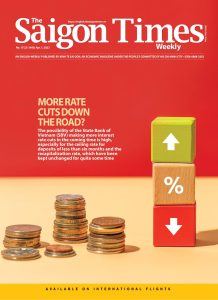The stock market has seen quite a positive development since banks have begun lowering their deposit rates, particularly with realty stocks, plus the support from Decree 08 and Resolution 33 recently issued by the Government.
Waiting for a shift?
The second round of deposit interest rate reductions is taking place at most banks, with a degree of adjustment arguably the most drastic in the past two years. This time, along with the one right after that, deposit rates were uniformly cut to below 9.5% per annum in December last year, suggesting the end of the interest rate uptrend.
In this situation, investors are probably expecting interest rates to get stable or even go down, stimulating a shift back from savings to investment in the stock market, which is now considered undervalued.
With the highest interest rate for 12-month deposits now only 9% per annum as determined by a few banks, and 7.4% by the state-run ones, the P/E ratio of the savings channel is currently between 11 and 13.5, a significant improvement from 9-9.5 a few months ago. Meanwhile, the P/E ratio of the VN-Index is around 10.7 at present.
Although it has risen from 9.95 in late 2022, this figure is still lower than savings, demonstrating how mediocre the stock market’s valuation is currently. Notably, quite a few stocks with good fundamentals are still cheap.
As per statistics, over the past 15 years, there have been four times when stocks were dumped in times of crisis and chaos, dragging down the P/E valuation of the VN-Index to lower than 11. Those occasions were great opportunities for long-term investors, though. It is because, from these areas of low valuation, the VN-Index rebounded strongly by 35-150% in the following 12 months and always surpassed the old peaks.
That said, one must acknowledge that the current P/E ratio of the VN-Index remains modest, but it is supported by the 2022 profit results of the business community, with a positive growth momentum maintained, especially in the banking sector. Based on the forecasts for 2023, with high lending rates and a decline in export orders, corporate profits will certainly be dealt a hard blow. For this reason, the Forward P/E ratio of the VN-Index is probably much higher.
In addition, for money to shift from savings to stock investment, it will take time. To enjoy high interest rates, deposits must have a term of at least six months or longer over the past time. Therefore, assuming deposits made in the first two months of this year will gradually reach their maturity, starting from the second half of 2023, with interest rates already cut to a level no longer attractive enough, this source of cash will likely return to the stock market.
Waiting for supporting factors
With positive technical signals as the VN-Index has got out of the downward trend since mid-January this year, followed by the removal of obstacles in the corporate bond market via Decree 08/2023, which has led to the recent surge of real estate stocks, the rapid reduction in interest rates suggests several factors are in favor of the stock market.
However, with the general meetings season drawing near, investors will likely see a series of enterprises opt for a much more modest profit target considering the not-so-optimistic scenarios of interest expenses. This will be a factor that somewhat restrains the upswing of the market. Even so, if deposit rates further decline in the coming months, lending rates will certainly follow suit, and businesses will probably reap better profits than they set out at the beginning of the year.

Besides, a further drop in interest rates will make the appeal of the savings channel increasingly limited, boosting both the speed and intensity of the shift in cash from savings to securities, as well as making the valuation of stocks more tempting. Certain groups relying heavily on financial leverage will probably benefit the most from the downward trend of interest rates, including construction, real estate, financial services, electricity, information technology, retail, etc.
The average interest rate for new loans has fallen by 0.4 percentage point per annum, and 22 banks have lowered their average lending rates, which are, however, still 3-3.5 percentage points higher than in the same period last year, as per the statistics provided by the central bank.
Meanwhile, according to SSI Research, deposit and lending rates have both dwindled compared to late 2022 but remain beyond the actual demand of the economy.
Moreover, there are currently two factors that will possibly exert pressure on investor sentiment. First, it is the possibility of the U.S. Federal Reserve (Fed) increasing federal funds rates to a degree greater than expected, considering how the economic data of this nation has deviated from forecasts, especially when the labor market is still experiencing hot growth and inflation remains far from the target.
Second, it is the recent turmoil in the financial market stateside related to Silicon Valley Bank (SVB) and Signature Bank going bust, which some think could be the start of a new financial crisis. Reportedly, the Fed, the Federal Deposit Insurance Corporation and the U.S. Department of the Treasury are making urgent interventions, willing to support everyone with deposits at SVB and Signature Bank and prevent similar bank runs.
That said, perhaps, “every cloud has a silver lining”. Analysts believe the collapse of SVB in just 48 hours is the consequence of the Fed’s sharpest interest rate hikes in the past four decades in an attempt to tackle inflation. Goldman Sachs, in a recent assessment, said it is unlikely for the Fed to further increase interest rates due to the fall of SVB and Signature Bank. There is also the possibility of the world’s largest central bank soon reversing its policy with interest rate cuts once again, all to prop up its financial market, which is going through the greatest upheaval in the past decade.









